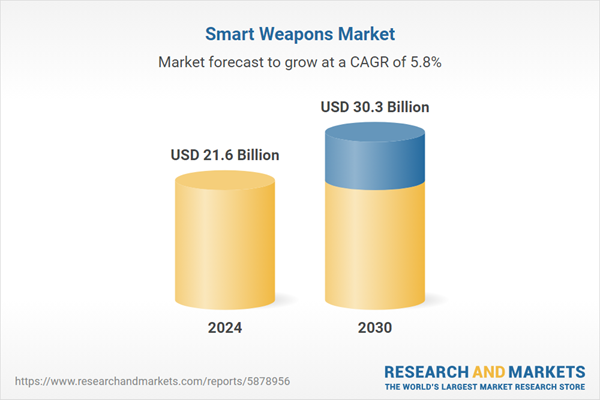Global Smart Weapons Market - Key Trends & Drivers Summarized
Smart weapons represent a significant advancement in modern military technology, incorporating advanced guidance systems, sensors, and data analytics to enhance precision, effectiveness, and situational awareness. These weapons include smart bombs, guided missiles, guided firearms, guided projectiles, guided rockets, directed energy weapons, precision-guided munitions, and smart bullets, each designed to strike targets with high accuracy while minimizing collateral damage. The integration of GPS, laser guidance, and infrared targeting systems allows smart weapons to adapt to changing conditions and targets in real-time. This technological sophistication not only improves mission success rates but also enhances the safety of military personnel by reducing the need for close combat and exposure to enemy fire.The development and deployment of smart weapons are driven by the increasing need for precision in modern warfare. Traditional weapons often lack the accuracy required for complex and high-stakes military operations, leading to unintended damage and casualties. Smart weapons address these issues by offering pinpoint accuracy, even in challenging environments. Additionally, the rising complexity of modern battlefields, where combatants often operate in densely populated urban areas, necessitates the use of weapons that can distinguish between hostile targets and civilians. Advances in artificial intelligence and machine learning are further enhancing the capabilities of smart weapons, enabling them to process vast amounts of data and make autonomous decisions in real-time.
The growth in the smart weapons market is driven by several factors. Firstly, the increasing demand for precision in military operations is pushing the adoption of advanced guided weapon systems. Secondly, technological advancements in guidance systems, sensors, and AI are enhancing the accuracy and reliability of smart weapons. Thirdly, the geopolitical landscape and rising defense budgets are driving investments in modernizing military arsenals with state-of-the-art weaponry. Lastly, the need to reduce collateral damage and civilian casualties in conflict zones is leading to the development and deployment of more sophisticated smart weapons. These factors collectively contribute to the rapid expansion and innovation in the smart weapons market.
Report Scope
The report analyzes the Smart Weapons market, presented in terms of market value (USD). The analysis covers the key segments and geographic regions outlined below.- Segments: Product Type (Missiles, Munitions, Guided Firearms, Guided Projectiles, Guided Rockets, Directed Energy Weapons, Other Product Types); Technology (Infrared, GPS, Laser, Radar, Other Technologies); Platform (Land, Air, Naval).
- Geographic Regions/Countries: World; USA; Canada; Japan; China; Europe; France; Germany; Italy; UK; Rest of Europe; Asia-Pacific; Rest of World.
Key Insights:
- Market Growth: Understand the significant growth trajectory of the Missiles segment, which is expected to reach US$9.9 Billion by 2030 with a CAGR of 5.3%. The Munitions segment is also set to grow at 5.8% CAGR over the analysis period.
- Regional Analysis: Gain insights into the U.S. market, valued at $6.4 Billion in 2024, and China, forecasted to grow at an impressive 6.2% CAGR to reach $2.9 Billion by 2030. Discover growth trends in other key regions, including Japan, Canada, Germany, and the Asia-Pacific.
Why You Should Buy This Report:
- Detailed Market Analysis: Access a thorough analysis of the Global Smart Weapons Market, covering all major geographic regions and market segments.
- Competitive Insights: Get an overview of the competitive landscape, including the market presence of major players across different geographies.
- Future Trends and Drivers: Understand the key trends and drivers shaping the future of the Global Smart Weapons Market.
- Actionable Insights: Benefit from actionable insights that can help you identify new revenue opportunities and make strategic business decisions.
Key Questions Answered:
- How is the Global Smart Weapons Market expected to evolve by 2030?
- What are the main drivers and restraints affecting the market?
- Which market segments will grow the most over the forecast period?
- How will market shares for different regions and segments change by 2030?
- Who are the leading players in the market, and what are their prospects?
Report Features:
- Comprehensive Market Data: Independent analysis of annual sales and market forecasts in US$ Million from 2024 to 2030.
- In-Depth Regional Analysis: Detailed insights into key markets, including the U.S., China, Japan, Canada, Europe, Asia-Pacific, Latin America, Middle East, and Africa.
- Company Profiles: Coverage of players such as BAE Systems PLC, Collins Aerospace, Boeing Company, The, Ball Corporation, China Aerospace Science and Technology Corporation (CASC) and more.
- Complimentary Updates: Receive free report updates for one year to keep you informed of the latest market developments.
Some of the 80 companies featured in this Smart Weapons market report include:
- BAE Systems PLC
- Collins Aerospace
- Boeing Company, The
- Ball Corporation
- China Aerospace Science and Technology Corporation (CASC)
- Almaz-Antey
- Armament Systems & Procedures Inc. (ASP, Inc.)
- Bharat Dynamics Limited
- Combined Systems, Inc.
- Condor Non-Lethal Technologies
- Axon Enterprise, Inc.
- Adsys Controls, Inc.
- Applied Companies Corp.
- BlueHalo
- Baykar Technologies
This edition integrates the latest global trade and economic shifts into comprehensive market analysis. Key updates include:
- Tariff and Trade Impact: Insights into global tariff negotiations across 180+ countries, with analysis of supply chain turbulence, sourcing disruptions, and geographic realignment. Special focus on 2025 as a pivotal year for trade tensions, including updated perspectives on the Trump-era tariffs.
- Adjusted Forecasts and Analytics: Revised global and regional market forecasts through 2030, incorporating tariff effects, economic uncertainty, and structural changes in globalization. Includes historical analysis from 2015 to 2023.
- Strategic Market Dynamics: Evaluation of revised market prospects, regional outlooks, and key economic indicators such as population and urbanization trends.
- Innovation & Technology Trends: Latest developments in product and process innovation, emerging technologies, and key industry drivers shaping the competitive landscape.
- Competitive Intelligence: Updated global market share estimates for 2025, competitive positioning of major players (Strong/Active/Niche/Trivial), and refined focus on leading global brands and core players.
- Expert Insight & Commentary: Strategic analysis from economists, trade experts, and domain specialists to contextualize market shifts and identify emerging opportunities.
Table of Contents
Companies Mentioned (Partial List)
A selection of companies mentioned in this report includes, but is not limited to:
- BAE Systems PLC
- Collins Aerospace
- Boeing Company, The
- Ball Corporation
- China Aerospace Science and Technology Corporation (CASC)
- Almaz-Antey
- Armament Systems & Procedures Inc. (ASP, Inc.)
- Bharat Dynamics Limited
- Combined Systems, Inc.
- Condor Non-Lethal Technologies
- Axon Enterprise, Inc.
- Adsys Controls, Inc.
- Applied Companies Corp.
- BlueHalo
- Baykar Technologies
Table Information
| Report Attribute | Details |
|---|---|
| No. of Pages | 431 |
| Published | December 2025 |
| Forecast Period | 2024 - 2030 |
| Estimated Market Value ( USD | $ 21.6 Billion |
| Forecasted Market Value ( USD | $ 30.3 Billion |
| Compound Annual Growth Rate | 5.8% |
| Regions Covered | Global |









